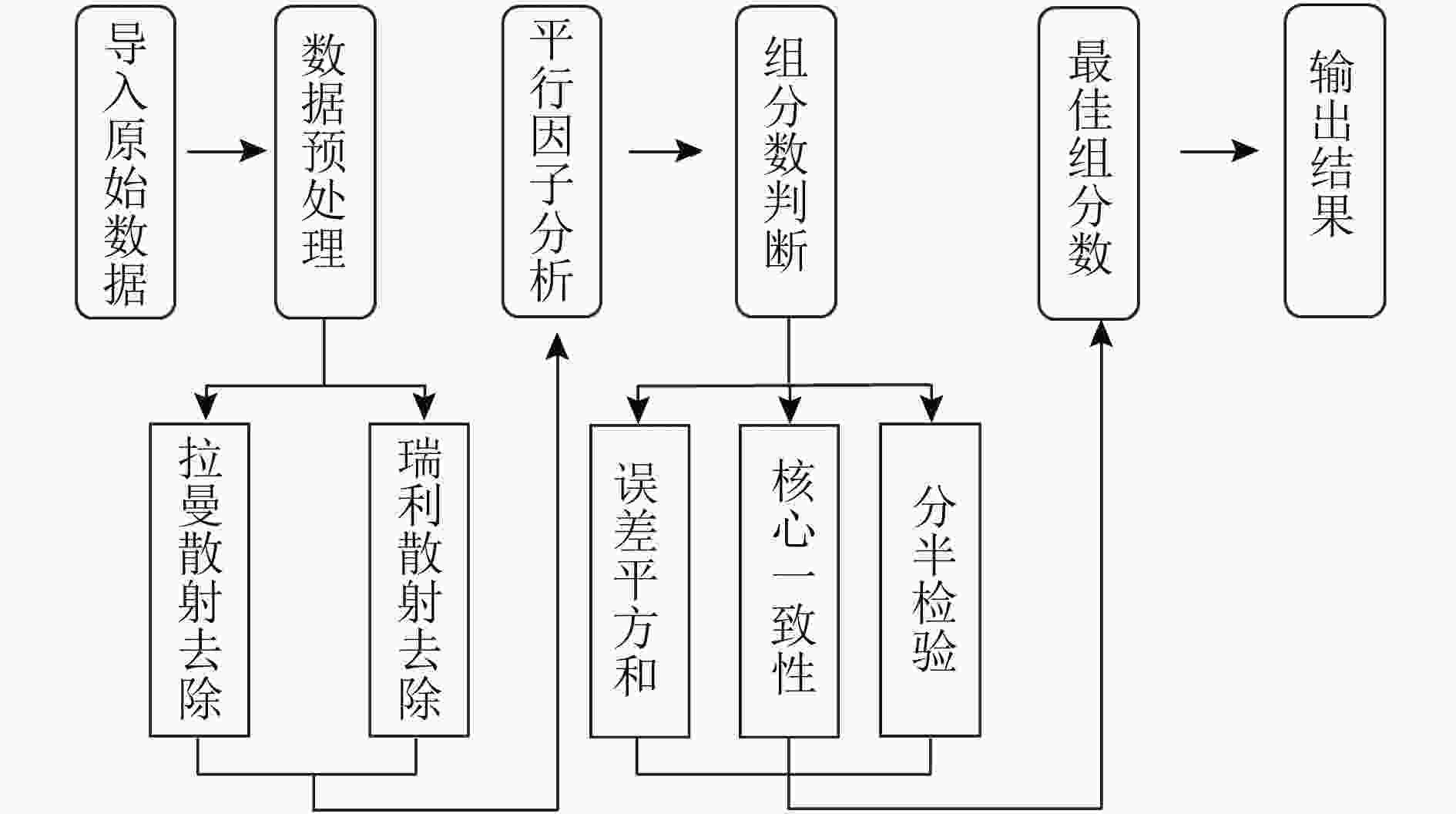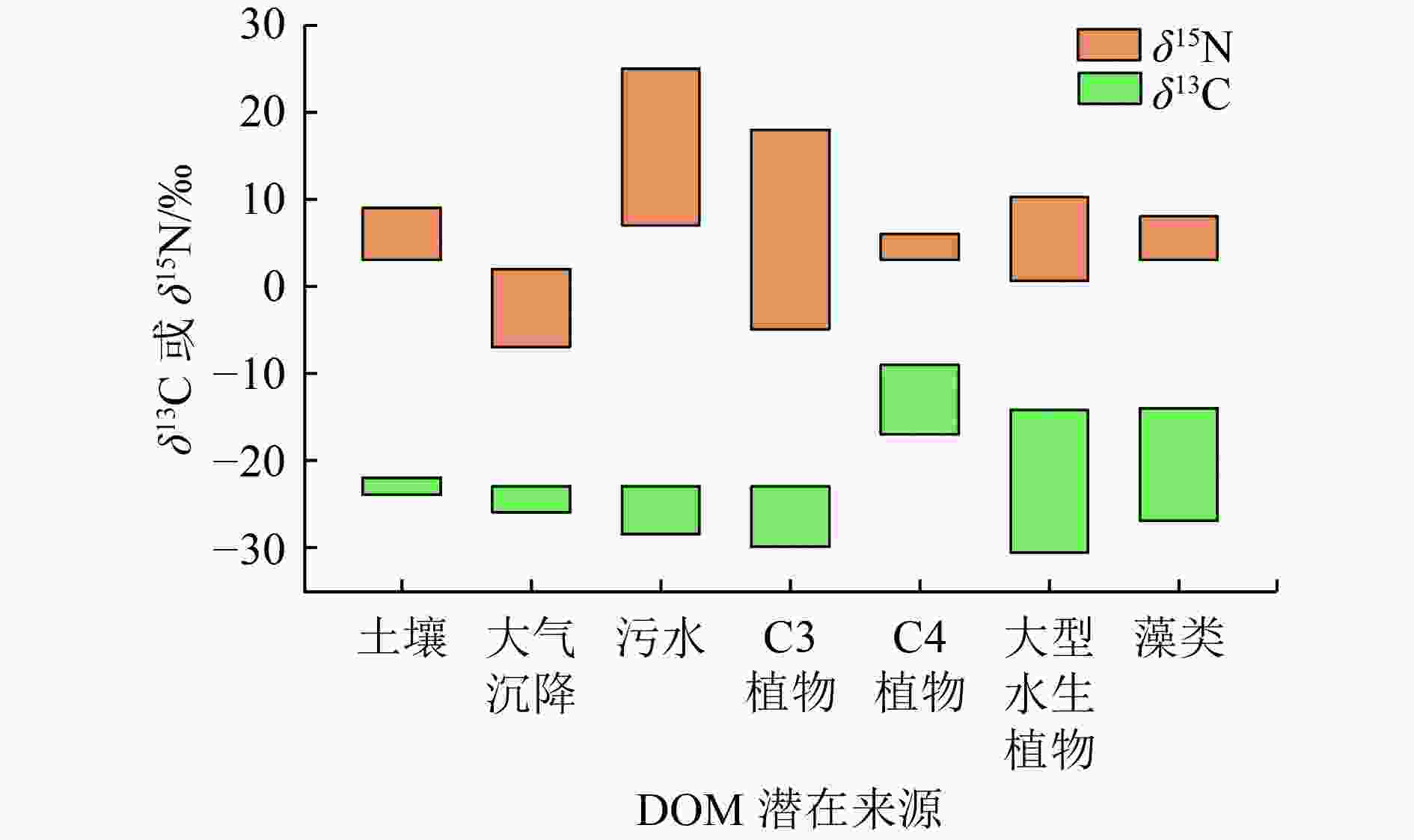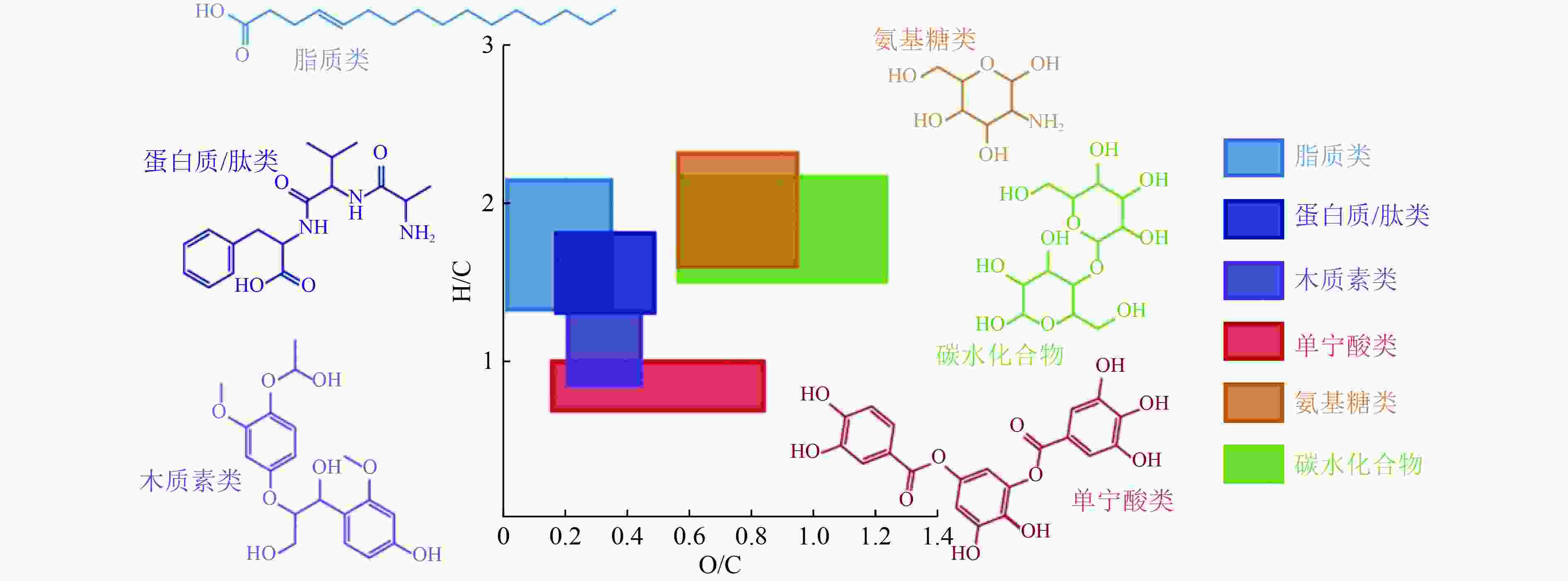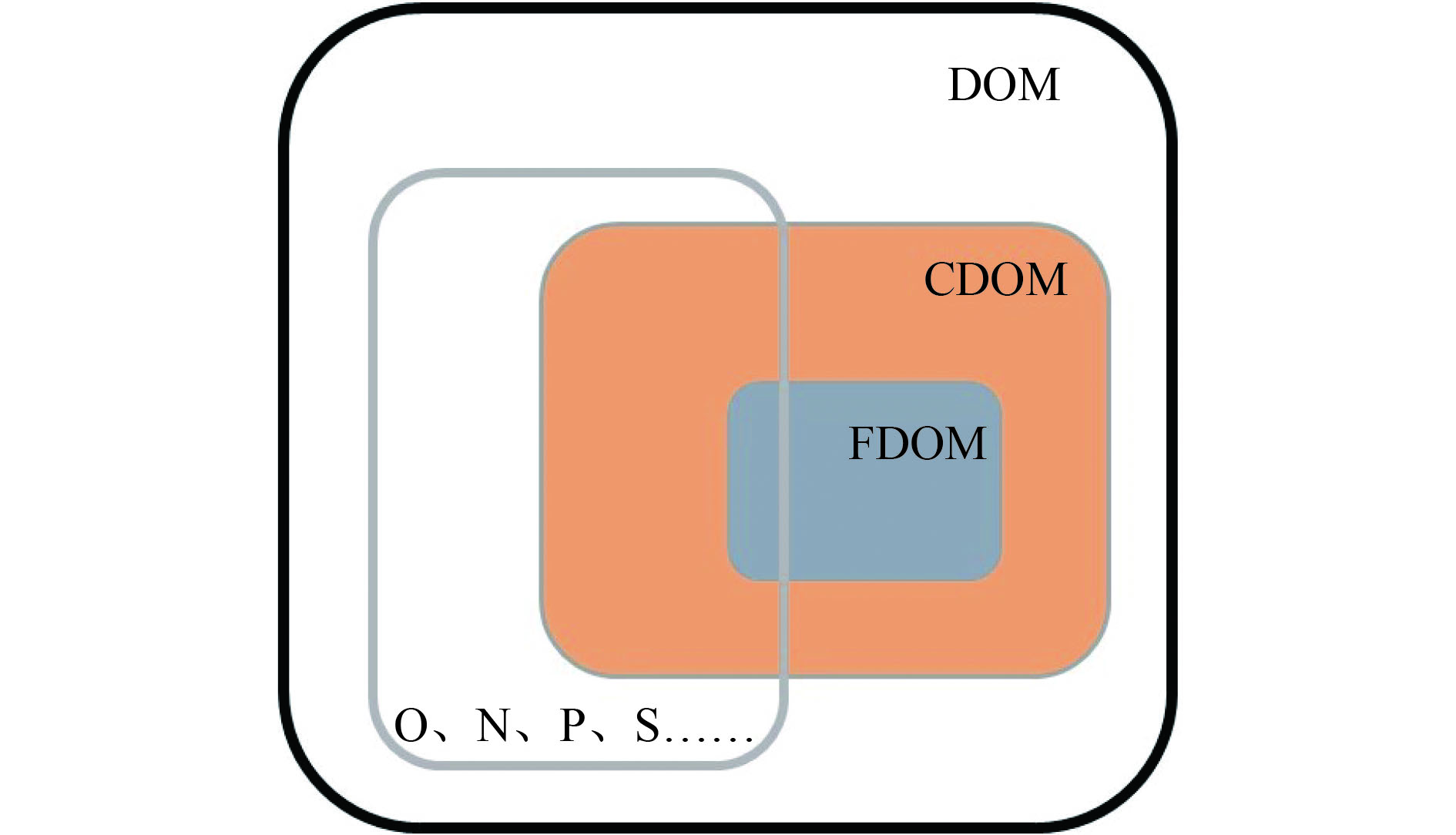Research progress on tracing and characterization of dissolved organic matter in water environment
-
摘要:
水体中的溶解性有机质(DOM)来源广泛,成分复杂,可参与水中重金属迁移转化和生物地球化学循环过程,采用相应技术手段识别水体DOM来源,实现对DOM组分和性质的表征,对理解其生态环境效应具有指示意义。简要介绍了水环境中DOM的组成、特点及当前的研究热点,重点总结归纳了紫外-可见吸收光谱、三维荧光光谱、稳定同位素、生物标志物以及傅里叶变换离子回旋共振质谱等技术方法在水环境DOM溯源与表征中的应用特点、重要表征参数、影响因素和使用局限性。结果表明:紫外-可见吸收光谱和三维荧光光谱均有操作便捷、分析速度快、不破坏样品等优点,但二者对DOM表征的侧重点不同;稳定同位素技术重点关注DOM中的碳、氮等元素同位素组成及含量,生物标志物可记录DOM分子结构的信息,而傅里叶变换离子回旋共振质谱则是从分子级别对DOM进行表征。以上各技术对DOM的研究均有广阔的应用前景,但是由于DOM成分和组成元素的复杂性以及每种技术本身的局限性,多种技术的联合使用已成为水体DOM表征与解析的发展趋势。在此基础上阐述了多技术联用条件、目标和优点,归纳了现有研究中基于多技术联用的水环境DOM研究进展及研究案例,最后展望了DOM溯源与表征的未来发展方向。
-
关键词:
- 溶解性有机质(DOM) /
- 溯源分析 /
- 结构表征 /
- 多技术联用
Abstract:Dissolved organic matter (DOM) in water has a wide range of sources and complex components, which can participate in the migration and transformation of heavy metals and biogeochemical cycles in water. Some technical means can be used to identify the source of DOM in water, and realize the characterization of DOM components and properties, so as to understand its ecological environmental effects. The composition, characteristics and current research hotspots of DOM in water environment were briefly introduced. The application characteristics, important characterization parameters, influencing factors and limitations of UV-Vis absorption spectroscopy, three-dimensional fluorescence spectroscopy, stable isotopes, biomarkers and FT-ICR-MS in the tracing and characterization of DOM in water environment were summarized and compared. The results showed that both UV-Vis absorption spectroscopy and three-dimensional fluorescence spectroscopy had the advantages of convenient operation, fast analysis speed and no sample destruction, but their emphasis on DOM characterization was different. Stable isotope technology focused on the isotopic composition and content of carbon, nitrogen and other elements in DOM, biomarkers could record the information of DOM molecular structure, while FT-ICR-MS could characterize DOM from the molecular level. All the above technologies have broad application prospects for DOM research. However, due to the complexity of DOM components and elements as well as the limitations of each technology, the combined use of multiple technologies has become the development trend of DOM characterization and analysis. Therefore, the conditions, objectives and advantages of multi-technology co-application were described, and the research progress and cases of water environment DOM based on multi-technology integration were summarized. Finally, the future development direction of DOM traceability and representation was prospected.
-
图 3 DOM潜在来源的碳、氮稳定同位素范围[47]
Figure 3. Ranges of carbon, nitrogen isotopic abundance for different DOM endmembers
图 4 基于Van Krevelen图的DOM物质类型划分[68]
Figure 4. Classification of DOM material types based on Van Krevelen diagram
特征参数 计算公式 含义 吸收系数(αλ) αλ=$ \dfrac{2.303\times A_\mathit{\lambda}}{l}\ $ 与CDOM浓度相关 单位有机碳含量吸光度(SUVA254) SUVA254 =$ \dfrac{{A}_{254}}{c\left(\mathrm{D}\mathrm{O}\mathrm{C}\right)} $ 代表腐殖化程度,与DOM中芳香族
化合物浓度呈正相关光谱斜率比(SR) SR=$ \dfrac{S_{275\sim295}}{S_{350\sim400}} $ 与DOM的平均分子量和芳香性呈负相关 吸收系数比 E2:E3=α250:α365,为250和365 nm处的吸收系数比 以3.5为界限,小于3.5以胡敏酸为主,
大于3.5以富里酸为主E2:E4 =α254:α436,为254和436 nm处的吸收系数比 指示有机物来源,低值为外源,高值为内源 E4:E6=α465:α665,为465和665 nm处的吸收系数比 与苯环碳聚合度呈负相关 注:λ为波长;A(λ)为吸光度;l为光程;A254为254 nm处吸光度;c(DOC)为DOC浓度;S275~295为275~295 nm范围内的吸收斜率;S350~400为350~400 nm范围内的吸收斜率。 光学指标 计算方法 表征含义 荧光指数 (FI) FI=$ \dfrac{F_{\lambda_{\mathrm{em}}=450\ \mathrm{nm}}}{F_{\lambda_{\mathrm{em}=500\ \mathrm{nm}}}},\lambda_{\mathrm{e}\mathrm{x}}=370\; \mathrm{n}\mathrm{m} $ 分区段指示有机质来源 腐殖化指数 (HIX) $ \mathrm{HIX}=\dfrac{\displaystyle\int_{435\mathrm{~nm}}^{480\mathrm{~nm}}F_{\lambda_{\mathrm{em}}}}{\displaystyle\int_{300\mathrm{~nm}}^{345\mathrm{~nm}}F_{\lambda_{\mathrm{em}}}},\; \; \lambda_{\mathrm{ex}}=254\mathrm{~nm} $ 表征有机质的腐殖化程度,HIX 越高则说明
腐殖化程度越高,有机质越稳定自生源指数 (BIX) BIX =$ \dfrac{F_{\lambda\mathrm{_{em}}=380\; \mathrm{n}\mathrm{m}}}{F_{\lambda_{\mathrm{em}=430\; \mathrm{n}\mathrm{m}}}},\lambda_{\mathrm{e}\mathrm{x}}=310\; \mathrm{n}\mathrm{m} $ BIX越高,表明DOM降解程度越高,越容易生成自生源产物 新鲜度指数(β:α) $ \beta:\alpha=\dfrac{F_{\lambda_{\mathrm{em}}=380\mathrm{~nm}}}{\displaystyle\int_{420\mathrm{~nm}}^{435\mathrm{~nm}}\; F_{\lambda_{\mathrm{em}}}},\; \; \lambda_{\mathrm{ex}}=310\mathrm{~nm} $ 表示新生成DOM在总体DOM中所占的比例 Fn(280) Fn(280)是Ex=280 nm时,Em在340~360 nm处的最大荧光强度 代表类蛋白物质的相对浓度水平 Fn(335) Fn(355)是Ex=355 nm时,Em在440~470 nm处的最大荧光强度 代表类腐殖物质的相对浓度水平 注:$ {\lambda }_{\mathrm{e}\mathrm{x}} $表示激发波长;$ {F}_{{\lambda }_{\mathrm{e}\mathrm{m}}} $表示发射波长对应的荧光强度;$\displaystyle \int_a^bF_{\lambda_{\mathrm{e}\mathrm{m}}} $表示发射波长在a~b波段内的光谱面积。 表 3 DOM溯源与表征分析技术对比
Table 3. Comparisons of DOM traceability and representation analysis techniques
技术类型 表征能力 优点 局限 UV-Vis 追踪DOM来源和反应性,实现对DOM的定性、定量分析和简单的结构分析 操作便捷,分析速度快,仪器普及率高且不破坏样品 分析能力有限,灵敏度略低,存在光散射现象 EEMs 追溯有机质来源和荧光物质类型 操作便捷,分析速度快,不破坏样品 分析能力有限,受内滤效应干扰,结果易受到多种因素的影响 稳定同位素
质谱表征物质C、N等元素的同位素组成及含量,定量DOM来源 表征DOM的范围广,可得到较为精确的定性和定量分析结果 缺乏统一的定量解析模型,解析结果受到端元种类、数量和同位素分馏等多种因素的影响 生物标志物 记录DOM分子结构信息,指示有机质输入、来源及传递过程 灵敏度高,生物标志物的种类多样且较为稳定 受多种环境因素的影响,同一种生物标志物可能来自不同门类生物 FT-ICR-MS 获得极高分辨率质谱图,表征DOM分子级别的结构信息 超高分辨率、超高质量精度和超高灵敏度 样品前处理复杂,获得的DOM碎片化信息有限,数据分析过程复杂,仪器使用成本高 表 4 多技术联用的水环境DOM研究案例
Table 4. Cases of multi-technique combined research on DOM
联用技术 研究重点 数据来源 UV-Vis、EEMs 中国云贵高原多个湖泊CDOM吸光
与荧光特征及其组成和来源文献[79] UV-Vis、EEMs-SOM 中国华东地区城市河流中DOM
浓度和成分的季节变化特征文献[80] UV-Vis、EEMs、
FT-IR中国长三角地区农村生活污水DOM
特征及组分的转化情况文献[81] EEMs、δ13C 澳大利亚某近海海湾DOM来源解析 文献[82] EEMs、δ13C、
生物标志物中国三峡水库支流藻华暴发期
DOM浓度、组成及来源分析文献[83] EEMs、δ 13C、
δ 15N、δ 18O韩国金刚江中东部的河流-流域系统
在季风前期、季风暴雨期和季风后期DOM来源与变化文献[84] EEMs、FT-ICR-MS 中国某市政污水处理厂A2O工艺
处理过程中DOM变化文献[85] EEMs、FT-ICR-MS 中国鄱阳湖DOM光学性质和
分子特征的空间变化文献[86] FT-ICR-MS、δ13C、EEMs、UV-Vis 美国Delaware海湾DOM
来源和性质的季节变化文献[87] FT-ICR-MS、δ13C 、13C-NMR 中国青藏高原地区盐湖及入湖河流
DOM起源、组成和循环分析文献[88] FT-ICR-MS、SEC、EEMs、1H-NMR 美国Hillsboro运河DOM分子组成的
时间演变和结构特征的变化文献[89] -
[1] ZHANG X L, YU H B, GAO H J, et al. Explore variations of DOM components in different landcover areas of riparian zone by EEM-PARAFAC and partial least squares structural equation model[J]. Spectrochimica Acta Part A:Molecular and Biomolecular Spectroscopy,2023,291:122300. doi: 10.1016/j.saa.2022.122300 [2] ZARK M, DITTMAR T. Universal molecular structures in natural dissolved organic matter[J]. Nature Communications,2018,9:3178. doi: 10.1038/s41467-018-05665-9 [3] BEGUM M S, PARK H Y, SHIN H S, et al. Separately tracking the sources of hydrophobic and hydrophilic dissolved organic matter during a storm event in an agricultural watershed[J]. Science of the Total Environment,2023,873:162347. doi: 10.1016/j.scitotenv.2023.162347 [4] ZHANG X L, NIE L, GAO H J, et al. Applying second derivative synchronous fluorescence spectroscopy combined with Gaussian band fitting to trace variations of DOM fractions along an urban river[J]. Ecological Indicators,2023,146:109872. doi: 10.1016/j.ecolind.2023.109872 [5] HANSEN A M, KRAUS T E C, PELLERIN B A, et al. Optical properties of dissolved organic matter (DOM): effects of biological and photolytic degradation[J]. Limnology and Oceanography,2016,61(3):1015-1032. doi: 10.1002/lno.10270 [6] NEBBIOSO A, PICCOLO A. Molecular characterization of dissolved organic matter (DOM): a critical review[J]. Analytical and Bioanalytical Chemistry,2013,405(1):109-124. doi: 10.1007/s00216-012-6363-2 [7] ZHAO P P, DU Z L, FU Q L, et al. Molecular composition and chemodiversity of dissolved organic matter in wastewater sludge via Fourier transform ion cyclotron resonance mass spectrometry: effects of extraction methods and electrospray ionization modes[J]. Water Research,2023,232:119687. doi: 10.1016/j.watres.2023.119687 [8] KALLE K, WATTENBERG H. Über den kupfergehalt des oZeanwassers[J]. Naturwissenschaften,1938,26(38):630-631. [9] KALLE G P, AGRAWAL A K, SIVASUBRAMANIAN P. Mutation to ultraviolet resistance and filament formation in bacteria[J]. Indian Journal of Genetics and Plant Breeding,1966,26:431. [10] GUO W, YANG F, LI Y P, et al. New insights into the source of decadal increase in chemical oxygen demand associated with dissolved organic carbon in Dianchi Lake[J]. Science of the Total Environment,2017,603/604:699-708. doi: 10.1016/j.scitotenv.2017.02.024 [11] IFON B E, ADYARI B, HOU L Y, et al. Insight into variation and controlling factors of dissolved organic matter between urban rivers undergoing different anthropogenic influences[J]. Journal of Environmental Management,2023,326:116737. doi: 10.1016/j.jenvman.2022.116737 [12] KELSO J E, BAKER M A. Organic matter sources and composition in four watersheds with mixed land cover[J]. Hydrobiologia,2022,849(12):2663-2682. doi: 10.1007/s10750-022-04884-y [13] MU G Y, JI M C, LI S J. Evaluation of CDOM sources and their links with antibiotics in the rivers dividing China and North Korea using fluorescence spectroscopy[J]. Environmental Science and Pollution Research,2018,25(27):27545-27560. doi: 10.1007/s11356-018-2773-9 [14] 朱宁美, 崔兵, 刘东萍, 等. 典型城市河流底泥溶解性有机质与重金属响应机制研究[J]. 环境工程技术学报,2021,11(6):1092-1101. doi: 10.12153/j.issn.1674-991X.20210093ZHU N M, CUI B, LIU D P, et al. Response mechanism of dissolved organic matter and heavy metals in sediments of typical urban rivers[J]. Journal of Environmental Engineering Technology,2021,11(6):1092-1101. doi: 10.12153/j.issn.1674-991X.20210093 [15] STEDMON C A, NELSON N B. The optical properties of DOM in the ocean[M]//Biogeochemistry of marine dissolved organic matter. Amsterdam: Elsevier, 2015: 481-508. [16] 王安月. 夏季长江口水体可溶有机质的组成及其空间展布特征[D]. 杭州: 浙江大学, 2021. [17] 言宗骋, 高红杰, 郭旭晶, 等. 蘑菇湖沉积物间隙水溶解性有机质紫外可见光谱研究[J]. 环境工程技术学报,2019,9(6):685-691. doi: 10.12153/j.issn.1674-991X.2019.05.160YAN Z C, GAO H J, GUO X J, et al. Study on UV-vis spectra of dissolved organic matter from sediment interstitial water in Moguhu Lake[J]. Journal of Environmental Engineering Technology,2019,9(6):685-691. doi: 10.12153/j.issn.1674-991X.2019.05.160 [18] HERZSPRUNG P, von TÜMPLING W, HERTKORN N, et al. Variations of DOM quality in inflows of a drinking water reservoir: linking of van Krevelen diagrams with EEMF spectra by rank correlation[J]. Environmental Science & Technology,2012,46(10):5511-5518. [19] HELMS J R, MAO J D, STUBBINS A, et al. Loss of optical and molecular indicators of terrigenous dissolved organic matter during long-term photobleaching[J]. Aquatic Sciences,2014,76(3):353-373. doi: 10.1007/s00027-014-0340-0 [20] BAO H Y, QIAO J, HUANG D K, et al. Molecular level characterization of the biolability of rainwater dissolved organic matter[J]. Science of the Total Environment,2023,862:160709. doi: 10.1016/j.scitotenv.2022.160709 [21] 芦晓峰, 朱山林, 张岚, 等. 乌伦古湖冰封期溶解性有机质分布特征及来源解析[J]. 环境工程技术学报,2023,13(5):1798-1807. doi: 10.12153/j.issn.1674-991X.20221092LU X F, ZHU S L, ZHANG L, et al. Dissolved organic matter distribution characteristics and source analysis of Ulungur Lake during ice sealing period[J]. Journal of Environmental Engineering Technology,2023,13(5):1798-1807. doi: 10.12153/j.issn.1674-991X.20221092 [22] FERRARI G M. The relationship between chromophoric dissolved organic matter and dissolved organic carbon in the European Atlantic coastal area and in the West Mediterranean Sea (Gulf of Lions)[J]. Marine Chemistry,2000,70(4):339-357. doi: 10.1016/S0304-4203(00)00036-0 [23] BREZONIK P L, OLMANSON L G, FINLAY J C, et al. Factors affecting the measurement of CDOM by remote sensing of optically complex inland waters[J]. Remote Sensing of Environment,2015,157:199-215. doi: 10.1016/j.rse.2014.04.033 [24] HELMS J R, STUBBINS A, RITCHIE J D, et al. Absorption spectral slopes and slope ratios as indicators of molecular weight, source, and photobleaching of chromophoric dissolved organic matter[J]. Limnology and Oceanography,2008,53(3):955-969. doi: 10.4319/lo.2008.53.3.0955 [25] LI P H, HUR J. Utilization of UV-Vis spectroscopy and related data analyses for dissolved organic matter (DOM) studies: a review[J]. Critical Reviews in Environmental Science and Technology,2017,47(3):131-154. doi: 10.1080/10643389.2017.1309186 [26] CHEN W, QIAN C, ZHOU K G, et al. Molecular spectroscopic characterization of membrane fouling: a critical review[J]. Chem,2018,4(7):1492-1509. doi: 10.1016/j.chempr.2018.03.011 [27] 吴东明, 何翠翠, 邓晓, 等. 土壤溶解性有机质的组分分离与表征技术研究进展[J]. 东北农业科学,2022,47(2):48-55.WU D M, HE C C, DENG X, et al. The technology of isolation and characterization for dissolved organic matter in soil[J]. Journal of Northeast Agricultural Sciences,2022,47(2):48-55. [28] STUBBINS A, LAPIERRE J F, BERGGREN M, et al. What's in an EEM: molecular signatures associated with dissolved organic fluorescence in boreal Canada[J]. Environmental Science & Technology,2014,48(18):10598-10606. [29] SPENCER R G M, GUO W D, RAYMOND P A, et al. Source and biolability of ancient dissolved organic matter in glacier and lake ecosystems on the Tibetan Plateau[J]. Geochimica et Cosmochimica Acta,2014,142:64-74. doi: 10.1016/j.gca.2014.08.006 [30] LI L, WANG Y, ZHANG W J, et al. New advances in fluorescence excitation-emission matrix spectroscopy for the characterization of dissolved organic matter in drinking water treatment: a review[J]. Chemical Engineering Journal,2020,381:122676. doi: 10.1016/j.cej.2019.122676 [31] McKNIGHT D M, BOYER E W, WESTERHOFF P K, et al. Spectrofluorometric characterization of dissolved organic matter for indication of precursor organic material and aromaticity[J]. Limnology and Oceanography,2001,46(1):38-48. doi: 10.4319/lo.2001.46.1.0038 [32] ZSOLNAY A, BAIGAR E, JIMENEZ M, et al. Differentiating with fluorescence spectroscopy the sources of dissolved organic matter in soils subjected to drying[J]. Chemosphere,1999,38(1):45-50. doi: 10.1016/S0045-6535(98)00166-0 [33] 李昊洋. 基于多技术联用的洱海有机质分布特征及溯源研究[D]. 北京: 北京交通大学, 2022. [34] COBLE P G. Characterization of marine and terrestrial DOM in seawater using excitation-emission matrix spectroscopy[J]. Marine Chemistry,1996,51(4):325-346. doi: 10.1016/0304-4203(95)00062-3 [35] CHEN W, WESTERHOFF P, LEENHEER J A, et al. Fluorescence excitation-emission matrix regional integration to quantify spectra for dissolved organic matter[J]. Environmental Science & Technology,2003,37(24):5701-5710. [36] MURPHY K R, STEDMON C A, GRAEBER D, et al. Fluorescence spectroscopy and multi-way techniques. PARAFAC[J]. Analytical Methods,2013,5(23):6557-6566. doi: 10.1039/c3ay41160e [37] BAI Y J, ZHANG S R, MU E L, et al. Characterizing the spatiotemporal distribution of dissolved organic matter (DOM) in the Yongding River Basin: insights from flow regulation[J]. Journal of Environmental Management,2023,325:116476. doi: 10.1016/j.jenvman.2022.116476 [38] ZHAO Y Q, SHEN J, FENG J M, et al. Relative contributions of different sources to DOM in Erhai Lake as revealed by PLS-PM[J]. Chemosphere,2022,299:134377. doi: 10.1016/j.chemosphere.2022.134377 [39] ZHANG W, LI T, DONG B. Characterizing dissolved organic matter in Taihu Lake with PARAFAC and SOM method[J]. Water Science and Technology:a Journal of the International Association on Water Pollution Research,2022,85(2):706-718. doi: 10.2166/wst.2022.010 [40] CUSS C W, McCONNELL S M, GUÉGUEN C. Combining parallel factor analysis and machine learning for the classification of dissolved organic matter according to source using fluorescence signatures[J]. Chemosphere,2016,155:283-291. doi: 10.1016/j.chemosphere.2016.04.061 [41] 刘健, 祁黎明, 于常红, 等. 三维荧光光谱应用于海水中有色溶解有机物分析的探讨[J]. 海洋环境科学,2014,33(4):650-656.LIU J, QI L M, YU C H, et al. Discussion about the application of excitation emission matrix spectroscopy in the analysis of colored dissolved organic matter in seawater[J]. Marine Environmental Science,2014,33(4):650-656. [42] 敖静, 王涛, 常瑞英. 三维荧光光谱法在土壤溶解性有机质组分解析中的应用[J]. 土壤通报,2022,53(3):738-746.AO J, WANG T, CHANG R Y. Application of the three-dimensional excitation-emission matrix fluorescence spectroscopy in the analysis of soil dissolved organic matter components[J]. Chinese Journal of Soil Science,2022,53(3):738-746. [43] 褚江勇, 廖振良. 水环境中溶解性有机物溯源分析及分子结构表征概述[J]. 能源环境保护,2020,34(2):1-7. doi: 10.3969/j.issn.1006-8759.2020.02.001CHU J Y, LIAO Z L. Source tracking and molecular structure characterization of dissolved organic matter in aqueous environment[J]. Energy Environmental Protection,2020,34(2):1-7. doi: 10.3969/j.issn.1006-8759.2020.02.001 [44] MILLIGAN H E, PRETZLAW T D, HUMPHRIES M M. Stable isotope differentiation of freshwater and terrestrial vascular plants in two subarctic regions[J]. Ecoscience,2010,17(3):265-275. [45] 刘金亮, 薛滨, 姚书春, 等. 湖泊水生植物稳定碳同位素分馏机制与应用研究进展[J]. 生态学报,2020,40(8):2533-2544.LIU J L, XUE B, YAO S C, et al. Mechanisms of stable carbon isotope fractionation of aquatic plants and the research advances of application[J]. Acta Ecologica Sinica,2020,40(8):2533-2544. [46] 林清, 王绍令. 沉水植物稳定碳同位素组成及影响因素分析[J]. 生态学报,2001,21(5):806-809. doi: 10.3321/j.issn:1000-0933.2001.05.018LIN Q, WANG S L. The composition of stable carbon isotope and some influencing factors of submerged plant[J]. Acta Ecologica Sinica,2001,21(5):806-809. doi: 10.3321/j.issn:1000-0933.2001.05.018 [47] LIU Y, WANG X Y, WEN Q, et al. Identifying sources and variations of organic matter in an urban river in Beijing, China using stable isotope analysis[J]. Ecological Indicators,2019,102:783-790. doi: 10.1016/j.ecolind.2019.03.023 [48] RIDDLE B, FOX J, MAHONEY D T, et al. Considerations on the use of carbon and nitrogen isotopic ratios for sediment fingerprinting[J]. Science of the Total Environment,2022,817:152640. doi: 10.1016/j.scitotenv.2021.152640 [49] LI Z W, WANG S L, NIE X D, et al. The application and potential non-conservatism of stable isotopes in organic matter source tracing[J]. Science of the Total Environment,2022,838:155946. doi: 10.1016/j.scitotenv.2022.155946 [50] YU X, ZHANG J L, KONG F L, et al. Identification of source apportionment and its spatial variability of dissolved organic matter in Dagu River-Jiaozhou Bay Estuary based on the isotope and fluorescence spectroscopy analysis[J]. Ecological Indicators,2019,102:528-537. doi: 10.1016/j.ecolind.2019.03.004 [51] DERRIEN M, KIM M S, OCK G, et al. Estimation of different source contributions to sediment organic matter in an agricultural-forested watershed using end member mixing analyses based on stable isotope ratios and fluorescence spectroscopy[J]. Science of the Total Environment,2018,618:569-578. doi: 10.1016/j.scitotenv.2017.11.067 [52] CARNEIRO L M, DO ROSÁRIO ZUCCHI M, de JESUS T B, et al. δ13C, δ15N and TOC/TN as indicators of the origin of organic matter in sediment samples from the estuary of a tropical river[J]. Marine Pollution Bulletin,2021,172:112857. doi: 10.1016/j.marpolbul.2021.112857 [53] WU H, ZHANG H C, CHANG F Q, et al. Isotopic constraints on sources of organic matter and environmental change in Lake Yangzong, Southwest China[J]. Journal of Asian Earth Sciences,2021,217:104845. doi: 10.1016/j.jseaes.2021.104845 [54] 张昊, 李建平. 稳定碳同位素在草地生态系统碳循环中的应用与展望[J]. 水土保持研究,2021,28(1):394-400.ZHANG H, LI J P. Application and prospect of stable carbon isotope to the study of carbon cycle in grassland ecosystem[J]. Research of Soil and Water Conservation,2021,28(1):394-400. [55] FRY B. Alternative approaches for solving underdetermined isotope mixing problems[J]. Marine Ecology Progress Series,2013,472:1-13. doi: 10.3354/meps10168 [56] PHILLIPS D L, NEWSOME S D, GREGG J W. Combining sources in stable isotope mixing models: alternative methods[J]. Oecologia,2005,144(4):520-527. doi: 10.1007/s00442-004-1816-8 [57] YIN Z, LI L Q, LIU C Y, et al. Historical variations of sedimentary organic matter sources and their relationships with human socio-economic activities in multiple habitats of a shallow lake[J]. Ecological Indicators,2022,140:109011. doi: 10.1016/j.ecolind.2022.109011 [58] GUO Q J, WANG C Y, WEI R F, et al. Qualitative and quantitative analysis of source for organic carbon and nitrogen in sediments of rivers and lakes based on stable isotopes[J]. Ecotoxicology and Environmental Safety,2020,195:110436. doi: 10.1016/j.ecoenv.2020.110436 [59] HEDGES J I, OADES J M. Comparative organic geochemistries of soils and marine sediments[J]. Organic Geochemistry,1997,27(7/8):319-361. [60] 梁作兵, 孙玉川, 李建鸿, 等. 典型岩溶区地下河中溶解态脂类生物标志物来源解析及其变化特征[J]. 环境科学,2016,37(5):1814-1822.LIANG Z B, SUN Y C, LI J H, et al. Sources and variation characteristics of dissolved lipid biomarkers in a typical Karst underground river[J]. Environmental Science,2016,37(5):1814-1822. [61] CHEN Y, ZHAO Z H, WANG Y H, et al. Effects of organic carbon burial on biomarker component changes in contamination in northeast Dianchi watershed[J]. Journal of Hazardous Materials,2023,445:130474. doi: 10.1016/j.jhazmat.2022.130474 [62] BHANDARI R, ROUTH J, SHARMA S, et al. Contrasting lipid biomarkers in mountain rivers in the Nepal Himalayas: organic matter characteristics and contribution to the fluvial carbon pool[J]. Geoscience Frontiers,2021,12(6):101231. doi: 10.1016/j.gsf.2021.101231 [63] 蒲阳, 葛井莲, 何天豪, 等. 太阳辐射影响高原生态系统的湖泊沉积生物标志物证据[J]. 地球科学前沿,2018,8(1):9-18. [64] COMISAROW M B, MARSHALL A G. Fourier transform ion cyclotron resonance spectroscopy[J]. Chemical Physics Letters,1974,25(2):282-283. doi: 10.1016/0009-2614(74)89137-2 [65] FIEVRE A, SOLOUKI T, MARSHALL A G, et al. High-resolution Fourier transform ion cyclotron resonance mass spectrometry of humic and fulvic acids by laser desorption/ionization and electrospray ionization[J]. Energy & Fuels,1997,11(3):554-560. [66] 何晨, 何丁, 陈春茂, 等. 傅里叶变换离子回旋共振质谱在溶解性有机质组成分析中的应用[J]. 中国科学:地球科学,2022,52(12):2323-2341. doi: 10.1360/SSTe-2021-0390HE C, HE D, CHEN C M, et al. Application of Fourier transform ion cyclotron resonance mass spectrometry in molecular characterization of dissolved organic matter[J]. Scientia Sinica (Terrae),2022,52(12):2323-2341. doi: 10.1360/SSTe-2021-0390 [67] KIM S, KRAMER R W, HATCHER P G. Graphical method for analysis of ultrahigh-resolution broadband mass spectra of natural organic matter, the van Krevelen diagram[J]. Analytical Chemistry,2003,75(20):5336-5344. doi: 10.1021/ac034415p [68] LASZAKOVITS J R, MacKAY A A. Data-based chemical class regions for van Krevelen diagrams[J]. Journal of the American Society for Mass Spectrometry,2022,33(1):198-202. doi: 10.1021/jasms.1c00230 [69] LIU S S, HE Z Q, TANG Z, et al. Linking the molecular composition of autochthonous dissolved organic matter to source identification for freshwater lake ecosystems by combination of optical spectroscopy and FT-ICR-MS analysis[J]. Science of the Total Environment,2020,703:134764. doi: 10.1016/j.scitotenv.2019.134764 [70] GONSIOR M, PEAKE B M, COOPER W T, et al. Photochemically induced changes in dissolved organic matter identified by ultrahigh resolution Fourier transform ion cyclotron resonance mass spectrometry[J]. Environmental Science & Technology,2009,43(3):698-703. [71] WEN Z D, SONG K S, LIU G, et al. Characterizing DOC sources in China’s Haihe River Basin using spectroscopy and stable carbon isotopes[J]. Environmental Pollution,2020,258:113684. doi: 10.1016/j.envpol.2019.113684 [72] RUAN M Q, WU F C, SUN F H, et al. Molecular-level exploration of properties of dissolved organic matter in natural and engineered water systems: a critical review of FTICR-MS application[J]. Critical Reviews in Environmental Science and Technology,2023,53(16):1534-1562. doi: 10.1080/10643389.2022.2157167 [73] ZHEREBKER A, RUKHOVICH G D, SARYCHEVA A, et al. Aromaticity index with improved estimation of carboxyl group contribution for biogeochemical studies[J]. Environmental Science & Technology,2022,56(4):2729-2737. [74] D’ANDRILLI J, COOPER W T, FOREMAN C M, et al. An ultrahigh-resolution mass spectrometry index to estimate natural organic matter lability[J]. Rapid Communications in Mass Spectrometry:RCM,2015,29(24):2385-2401. doi: 10.1002/rcm.7400 [75] HERTKORN N, FROMMBERGER M, WITT M, et al. Natural organic matter and the event horizon of mass spectrometry[J]. Analytical Chemistry,2008,80(23):8908-8919. doi: 10.1021/ac800464g [76] KELLERMAN A M, GUILLEMETTE F, PODGORSKI D C, et al. Unifying concepts linking dissolved organic matter composition to persistence in aquatic ecosystems[J]. Environmental Science & Technology,2018,52(5):2538-2548. [77] YUAN K T, WAN Q, CHAI B B, et al. Characterizing the effects of stormwater runoff on dissolved organic matter in an urban river (Jiujiang, Jiangxi Province, China) using spectral analysis[J]. Environmental Science and Pollution Research,2023,30(17):50649-50660. doi: 10.1007/s11356-023-25933-6 [78] 马文娟, 刘丹妮, 杨芳, 等. 水环境中污染物同位素溯源的研究进展[J]. 环境工程技术学报,2020,10(2):242-250. doi: 10.12153/j.issn.1674-991X.20190081MA W J, LIU D N, YANG F, et al. Research progress in isotope methods for tracing contaminants in water environment[J]. Journal of Environmental Engineering Technology,2020,10(2):242-250. doi: 10.12153/j.issn.1674-991X.20190081 [79] ZHANG Y L, ZHANG E L, YIN Y, et al. Characteristics and sources of chromophoric dissolved organic matter in lakes of the Yungui Plateau, China, differing in trophic state and altitude[J]. Limnology and Oceanography,2010,55(6):2645-2659. doi: 10.4319/lo.2010.55.6.2645 [80] JIN X C, CHEN X Q, GAO L M, et al. The spectral resolution of DOM in urban rivers affected by different non-point source intensities using self-organizing maps[J]. Water Science and Technology,2023,88(1):266-277. doi: 10.2166/wst.2023.187 [81] LAN J J, LIU L L, WANG X, et al. DOM tracking and prediction of rural domestic sewage with UV-vis and EEM in the Yangtze River Delta, China[J]. Environmental Science and Pollution Research,2022,29(49):74579-74590. doi: 10.1007/s11356-022-20979-4 [82] CAWLEY K M, DING Y, FOURQUREAN J, et al. Characterising the sources and fate of dissolved organic matter in Shark Bay, Australia: a preliminary study using optical properties and stable carbon isotopes[J]. Marine and Freshwater Research,2012,63(11):1098. doi: 10.1071/MF12028 [83] XIANG R, TIAN Z B, ZHANG C D, et al. Characterization of dissolved organic matter content, composition, and source during spring algal bloom in tributaries of the Three Gorges Reservoir[J]. Science of the Total Environment,2023,879:163139. doi: 10.1016/j.scitotenv.2023.163139 [84] KIM M S, LIM B R, JEON P, et al. Innovative approach to reveal source contribution of dissolved organic matter in a complex river watershed using end-member mixing analysis based on spectroscopic proxies and multi-isotopes[J]. Water Research,2023,230:119470. doi: 10.1016/j.watres.2022.119470 [85] TANG G, LI B R, ZHANG B W, et al. Dynamics of dissolved organic matter and dissolved organic nitrogen during anaerobic/anoxic/oxic treatment processes[J]. Bioresource Technology,2021,331:125026. doi: 10.1016/j.biortech.2021.125026 [86] XU L, HU Q, JIAN M F, et al. Exploring the optical properties and molecular characteristics of dissolved organic matter in a large river-connected lake (Poyang Lake, China) using optical spectroscopy and FT-ICR MS analysis[J]. Science of the Total Environment,2023,879:162999. doi: 10.1016/j.scitotenv.2023.162999 [87] POWERS L C, LUEK J L, SCHMITT-KOPPLIN P, et al. Seasonal changes in dissolved organic matter composition in Delaware Bay, USA in March and August 2014[J]. Organic Geochemistry,2018,122:87-97. doi: 10.1016/j.orggeochem.2018.05.005 [88] ZHANG Y L, YANG K L, CHEN H M, et al. Origin, composition, and accumulation of dissolved organic matter in a hypersaline lake of the Qinghai-Tibet Plateau[J]. Science of the Total Environment,2023,868:161612. doi: 10.1016/j.scitotenv.2023.161612 [89] HARIR M, CAWLEY K M, HERTKORN N, et al. Molecular and spectroscopic changes of peat-derived organic matter following photo-exposure: effects on heteroatom composition of DOM[J]. Science of the Total Environment,2022,838:155790. ◇ doi: 10.1016/j.scitotenv.2022.155790 -




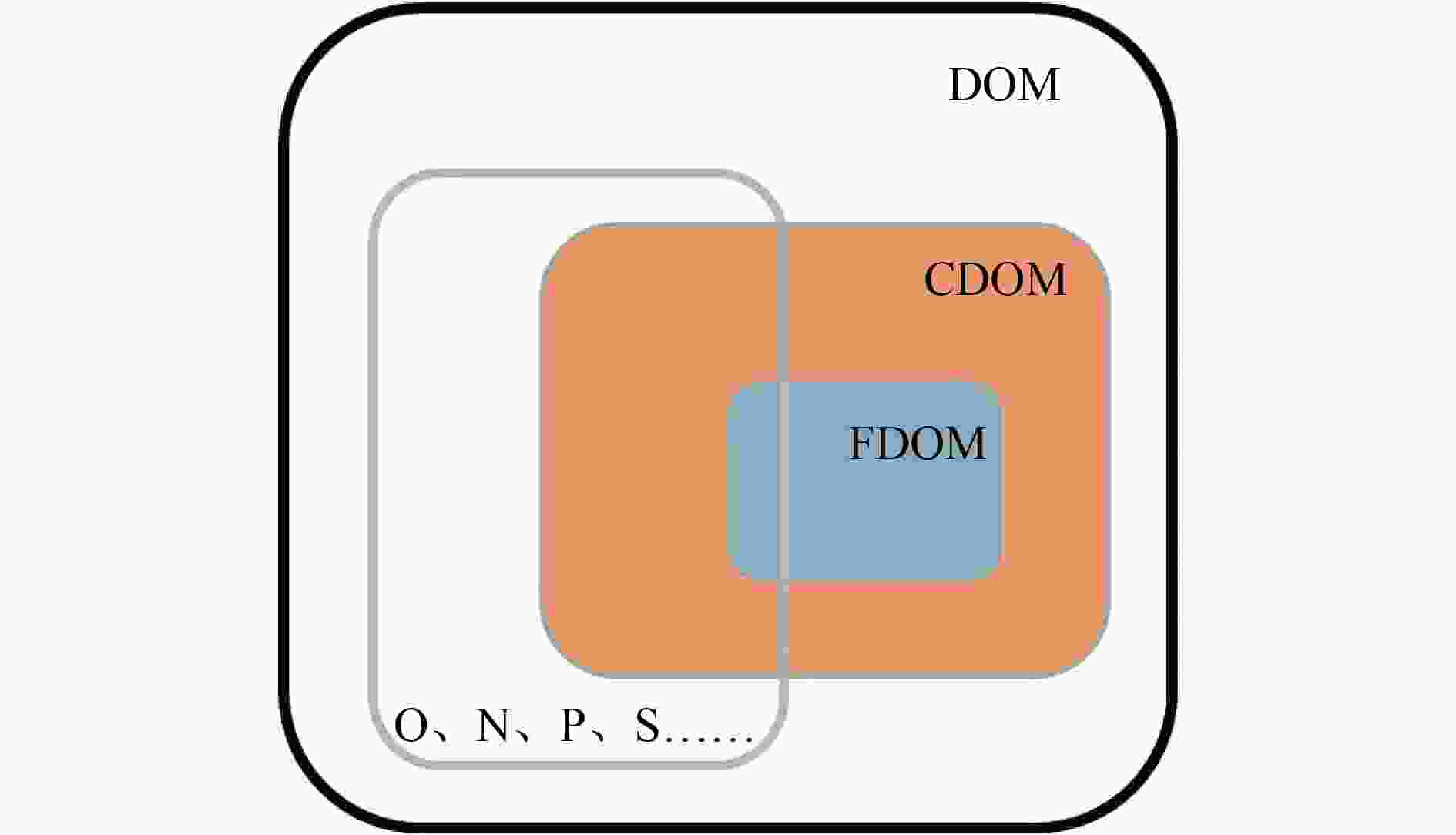
 下载:
下载:
